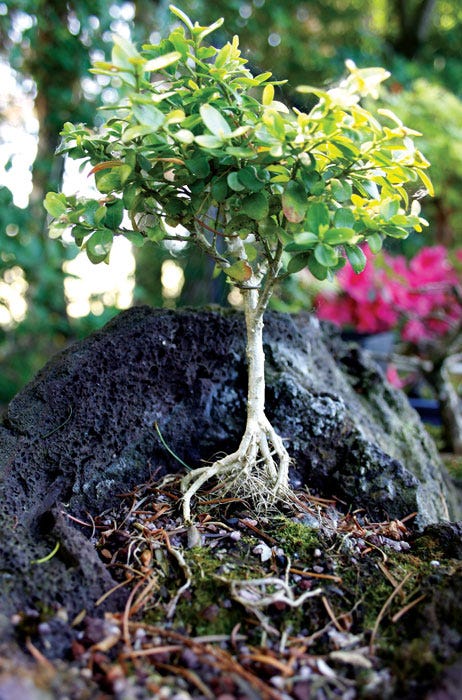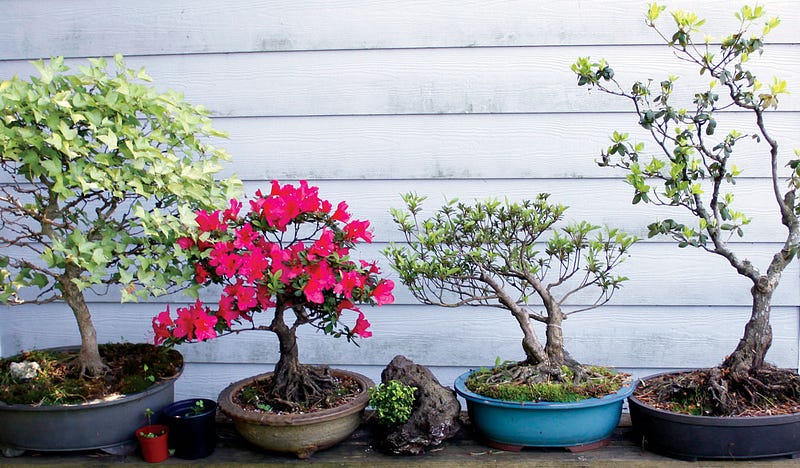Nurturing Bonsai
Ancient Asian art takes root in Northwest
STORY BY GRACE SCHRATER
photos by Evan Abell and Grace Schrater
A pair of pruning shears in hand, George Berkompas strolls around his backyard — his personal oasis — tending to his approximately 120 miniature potted plants. He has thoughtfully placed each pot outside to thrive in the temperate, usually moist Bellingham environment.
Berkompas considers himself an artist — his art form: bonsai plants.

“Like an artist with [a] painting, there are different mediums you can use,” Berkompas says. “That’s the same with different trees you can use in bonsai.”
Berkompas was introduced to the art when his wife got him a bonsai tree for Christmas in 1987.
“[Bellingham] is probably one of the best areas in the whole world [for bonsai],” Berkompas says. “I think the Japanese are kind of jealous about our place to grow here.”
The Japanese climate gets colder in the winter, and the region’s moss selection — which helps add nutrients to the soil — is not nearly as diverse as that of the Northwest, Berkompas says.
“Bonsai” translates from Japanese to “tree in a pot,” Berkompas says. He likens a bonsai plant to a goldfish in a bowl — if kept in a small container, the roots will have little room to expand, and the tree will remain a miniature size of its parent plant. Because the containers restrict the size of the plants, people are able to determine the size of the plant they desire.
In 2010, Berkompas found he was not the only person in Bellingham interested in the art of bonsai when he discovered the Whatcom/Skagit Bonsai Society.
The group meets the third Tuesday of every month. Each member brings a few plants to work on, and peers offer guidance about horticulture and artistic techniques, says Bonsai Society member Amy McNitt.
Any plant can be turned into a bonsai, but the most common are azaleas, rhododendrons, short needle pines, junipers and Japanese maples, Berkompas says.
A fruit tree can be turned into a bonsai plant — but Berkompas says that it has to be the right kind of fruit tree, because while the tree is miniaturized, the fruit remains its common size.
“I just like how it looks like a gigantic tree, but it’s tiny.”
“The fruit does not shrink,” Berkompas says. “You have a tree that’s a foot tall with an apple that’s about four inches in diameter on it.”
Berkompas has successfully kept blueberry and huckleberry bonsai.
“They taste good, too,” Berkompas says.
The art of bonsai originated in China more than a thousand years ago. Japan then refined it, and the United States has further refined it since, Berkompas says.
“They have definite styles in Japan, and we’ve modified those styles,” Berkompas says. “[A Japanese bonsai is] like a Doug fir growing out in the forest, just straight as can be. We’ve let a little movement come in there. That doesn’t bother us.”
Whereas the Japanese strive for the tree to be as straight and uniform as possible, the U.S. tends to experiment more with individual techniques such as braiding the trunks while they are still young and flimsy, or placing rocks under the roots so they clutch the rocks like a hand, Berkompas says.
The art is often passed down through teaching a complicated formula of success, and, if done right, the trees can outlive their parent plants.
“The bonsai trees will live longer than the larger trees that they are a junior size of, and that’s the reason people pass them down from generation to generation,” Berkompas says. “I have a friend that harvested [a bonsai tree] more than 800 years old, and it’s growing very well.”
“We just have a good time working on our little trees.”
Berkompas admits that keeping the plants healthy can involve a demanding ritual, which includes pruning the branches, watering — the most critical part to keeping bonsai alive — and having the right soil mixture and fertilizer.
Western student and bonsai plant owner Sean Devers does not feel the plants are too hard to keep healthy, he says, as long as each plant is watered every couple days and the branches are trimmed every month.
Devers owns a Chinese elm bonsai, a green spiky-looking tree that is about 10 inches tall and seven inches wide. He received his first bonsai as a Christmas present in 2013, and continues to seek advice on watering and pruning through tutorials on the Internet.
“I just like how it looks like a gigantic tree, but it’s tiny,” Devers says. “It’s in our living room and it’s a really good centerpiece.”

Devers says caring for bonsai offers a sort of Zen quality.
“It gives the room a nice vibe,” Devers says.
Berkompas describes his backyard as therapeutic — a nice escape from life stressors. Sharing the passion with his fellow society members can also be therapy in itself.
“People bring their trees and we work on them,” Berkompas says. “People get more eyes looking at [their bonsais] and they get different people’s ideas and interpretations.”
The group participates in an annual local garden show in the spring, as well as various shows throughout the year, McNitt says.
“We just have a good time working on our little trees,” McNitt says.
Owning a bonsai offers the joy of taking care of another living object, Berkompas says, and belonging to a community that shares an appreciation for the art keeps him devoted to bonsai after 27 years.
In the years to come, Berkompas will continue to tend to his garden of miniature trees, delicately trimming their tiny branches and watching them grow in the cool Northwest air.